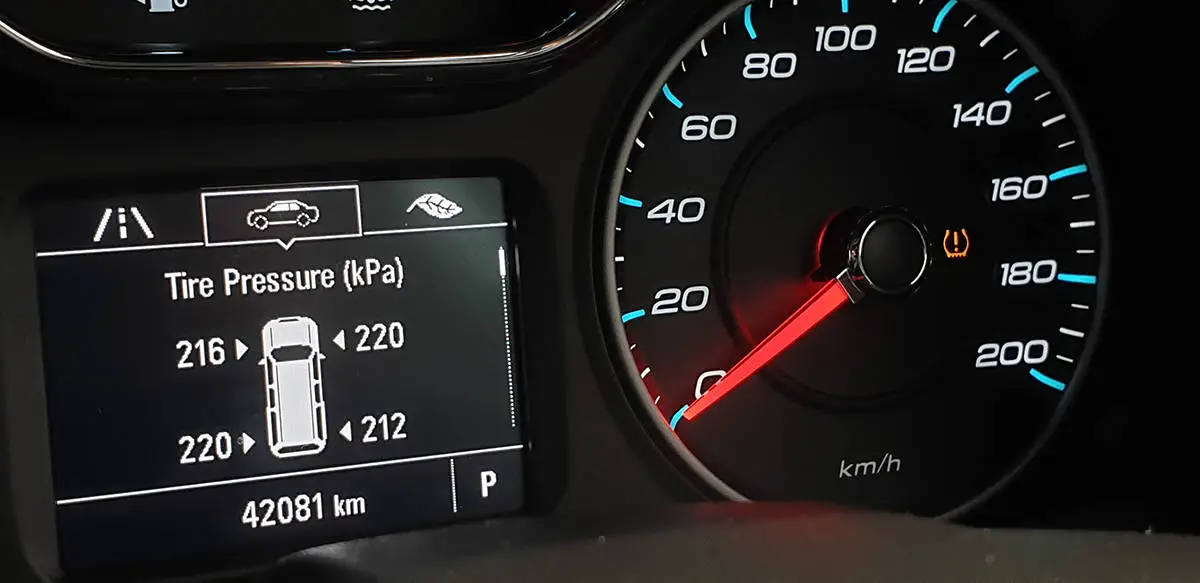Several things can go wrong if you attempt to operate your car with flat or underinflated tires. Luckily, most carmakers, including Hyundai, have preinstalled a safety system called a tire-pressure monitoring system (TPMS) to inform drivers when any of the 4 tires are flat. But after fixing the underinflation problem, how do you reset it to the original settings on an Elantra?
On a Hyundai Elantra, you can find the TPMS reset button underneath the steering wheel. To reset the TPMS system, hold it for 5 seconds or until it blinks 3 times before letting go. Once you’ve reset the TPMS, it can take up to 20 minutes for the sensors to refresh.
Today, I’ll speak about what TPMS is, how it works, why resetting it is necessary, and how to troubleshoot common TPMS problems.
What Is TPMS?

TPMS stands for “Tire Pressure Monitoring System,” which is a system designed to monitor the air pressure in a vehicle’s tires and alert the driver when the pressure falls below a certain level.
Hyundai Elantras require between 32 and 33 PSI for each tire. If any of the tires are underinflated to a certain threshold (around 25%), the TPMS light will illuminate, informing you that you need to add air to the faulty tire.
Within a few minutes of driving, your dashboard will show you the precise PSI ratings for each of the 4 tires. The dashboard will flash orange to show you which tire or tires is underinflated. The TPMS light located to the bottom right-hand side of the speedometer will also illuminate.
How Does TPMS Work?
There are two types of TPMS, Direct, and Indirect. A direct TPMS uses sensors that are mounted inside the tires and transmit the pressure data to the vehicle’s onboard computer. An indirect TPMS uses the vehicle’s ABS (Anti-lock Braking System) wheel speed sensors to determine the rotational speed of the wheels and calculate the air pressure of the tires. Hyundai Elantras use direct TPMS to measure pressure in all four tires accurately.
TPMS operates by measuring the air pressure in the tires and comparing it to the recommended pressure specified by the vehicle manufacturer. The system typically uses sensors located inside the tires, which send information to a control module in the vehicle. The driver is then notified if the pressure in any of the tires falls below a certain level by a warning light on the dashboard.
Why Is Resetting TPMS Necessary?
So, if the system is continuously producing accurate tire pressure readings, why would you need to reset it in the first place?
When your car has some TPMS problems, incorrect pressure readings and false warnings can impair vehicle safety and performance. If you want the TPMS system to keep protecting your tires and the people inside your car, you must reset it when necessary.
Here are a few instances where it is mandatory to reset the TPMS on your Hyundai Elantra or any vehicle:
1. After adjusting the tire pressure
It is possible that the pressure sensor inside the tire will not accurately register the new pressure after making adjustments or corrections. After changing the pressure rating in your car’s tires, resetting the TPMS will ensure that it is set to the correct value.
2. After replacing the tires
The internal sensor of a brand-new tire is pre-programmed with a specific rolling diameter. Resetting the TPMS also ensures that the vehicle’s computer is getting accurate pressure readings after installing new tires, which can have different ratings and recommendations.
This only applies to vehicles with indirect TPMS systems. Elantras have direct TPMS, so no further maintenance is required.
3. After replacing the TPMS sensors
It is essential to reset the system after replacing TPMS sensors to ensure continued communication between the sensors and the vehicle’s central processing unit. When a TPMS sensor is replaced, it must be paired with the vehicle’s computer so that it can exchange wireless signals with the old sensors. The system needs to be reset so that the new sensors can communicate with the car’s computer and provide reliable tire pressure readings.
4. After disconnecting the car battery
The TPMS can become inoperable if the vehicle’s battery is removed. The reason for this is that the TPMS sensors and the system’s onboard computer draw their energy from the car’s battery. In order to ensure that the TPMS sensors and the vehicle’s computer are communicating properly and that the system is calibrated properly after the battery has been reconnected, it is necessary to reset the system.
5. After servicing
The tire pressure monitoring system (TPMS) in your car may get knocked out of sync if you take it in for service and the mechanic performs a certain procedure. Tire rotation, wheel alignment, and suspension adjustments can all shift a car’s tire configuration, necessitating a software update to reflect the new setup.
Because the wheels are often removed during brake service, the battery powering the sensors may be cut off, wiping out any previous readings; consequently, the system will need to be reset so that it can properly identify the sensors.
How to Reset the TPMS on a Hyundai Elantra
If you correct your car tires’ pressure after the TPMS indicator flashes, adding or removing air from the tires will not automatically shut off the indicator. To ensure everything is working as it should, you will need to reset the TPMS.
This is how you do it.
- Locate the TPMS reset button. On a Hyundai Elantra, the TPMS is usually found underneath or to the side of the steering wheel. You should consult the owner’s manual to determine the precise location of the reset button. It should have the TPMS emblem on it.
- Put the key in the ignition and turn it to the on position. This will supply power to all the electrical devices in your Elantra, including the TPMS, without turning the engine on.
- Press and hold the TPMS reset button for 3 to 5 seconds. You’ll know when you have successfully reset the TPMS after the TPMS light blinks 3 times.
- Start the car and idle it for 20 minutes. It will take a while for the TPMS to register a reset.
If you’re confident that you have inflated the tires to the correct specifications, but the TPMS light remains on, you can try driving around for 20 to 40 minutes. If the light remains on, then there might be something wrong with the TPMS’ electrical components.
Is TPMS Reliable?
Yes, it is, but that doesn’t mean you shouldn’t manually check the pressure rating of your tires.
The TPMS, like any electrical system in your vehicle, can go haywire for a number of reasons. This may cause inaccurate tire pressure readings, which can significantly impact your car’s performance, increase wear and tear, and possibly lead to blowouts. Even if the TPMS indicator is off, that doesn’t necessarily mean your tires are perfectly inflated.
You should still do your due diligence to manually check the pressure of your tires at least once every week. That way, you’ll know for certain whether your tires are overinflated, underinflated, or just right. Please note that the tires will lose pressure over time—at least 1 or 2 PSI every month on average.
What Can Damage the TPMS Sensors?
There are several things that can affect the sensors negatively, including:
- Water exposure
- Bumps
- Corrosion
- Friction
- Using the wrong valve core or nut when installing TPMS sensors
- Loose or disconnected wires
- Incorrect tire sizes
Whenever you replace a tire or get your vehicle serviced, make sure to ask the mechanic to check the TPMS to ensure it’s in working order.






